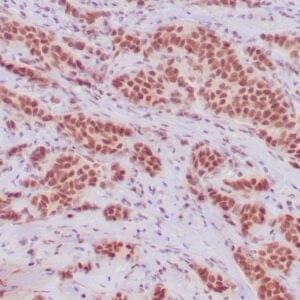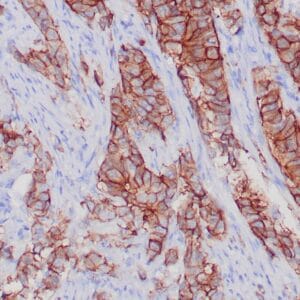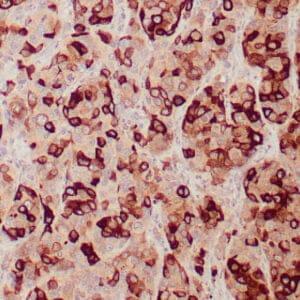| Weight | 1 lbs |
|---|---|
| Dimensions | 9 × 5 × 2 in |
| host | mouse |
| isotype | IgG |
| clonality | monoclonal |
| concentration | concentrate, predilute |
| applications | IHC |
| reactivity | human |
| available size | 0.1 mL, 0.5 mL, 1 mL concentrated, 7 mL prediluted |
rabbit anti-ER monoclonal antibody (ZR147) 6174
Price range: $160.00 through $528.00
Antibody summary
- Rabbit monoclonal to ER
- Suitable for: Immunohistochemistry (formalin-fixed, paraffin-embedded tissues)
- Reacts with: Human
- Isotype:IgG
- Control: Breast carcinoma
- Visualization: Nuclear
- 0.1, 0.5, 1.0 mL concentrated, 7 mL prediluted
rabbit anti-ER monoclonal antibody ZR147 6174
| antibody |
|---|
| Database link: human P03372 |
| Tested applications IHC |
| Recommended dilutions Concentrated 1:100-200 |
| Application Notes Positive control: Breast carcinoma |
| Immunogen Recombinant fragment (around aa495-595) of human ER alpha protein (exact sequence is proprietary) |
| Size and concentration 7 mL prediluted or 0.1, 0.5, 1.0 mL and concentrated |
| Form liquid |
| Storage Instructions 2-8°C for short term, for longer term at -20°C. Avoid freeze / thaw cycles. |
| Purity affinity purified |
| Clonality monoclonal |
| Isotype IgG |
| Compatible secondaries goat anti-rabbit IgG, H&L chain specific, peroxidase conjugated, conjugated polyclonal antibody 9512 goat anti-rabbit IgG, H&L chain specific, biotin conjugated polyclonal antibody 2079 goat anti-rabbit IgG, H&L chain specific, FITC conjugated polyclonal antibody 7863 goat anti-rabbit IgG, H&L chain specific, Cross Absorbed polyclonal antibody 2371 goat anti-rabbit IgG, H&L chain specific, biotin conjugated polyclonal antibody, crossabsorbed 1715 goat anti-rabbit IgG, H&L chain specific, FITC conjugated polyclonal antibody, crossabsorbed 1720 |
| Isotype control Rabbit polyclonal - Isotype Control |
| target relevance |
|---|
| Protein names Estrogen receptor (ER) (ER-alpha) (Estradiol receptor) (Nuclear receptor subfamily 3 group A member 1) |
| Gene names ESR1,ESR1 ESR NR3A1 |
| Protein family Nuclear hormone receptor family, NR3 subfamily |
| Mass 66216Da |
| Function FUNCTION: Nuclear hormone receptor. The steroid hormones and their receptors are involved in the regulation of eukaryotic gene expression and affect cellular proliferation and differentiation in target tissues. Ligand-dependent nuclear transactivation involves either direct homodimer binding to a palindromic estrogen response element (ERE) sequence or association with other DNA-binding transcription factors, such as AP-1/c-Jun, c-Fos, ATF-2, Sp1 and Sp3, to mediate ERE-independent signaling. Ligand binding induces a conformational change allowing subsequent or combinatorial association with multiprotein coactivator complexes through LXXLL motifs of their respective components. Mutual transrepression occurs between the estrogen receptor (ER) and NF-kappa-B in a cell-type specific manner. Decreases NF-kappa-B DNA-binding activity and inhibits NF-kappa-B-mediated transcription from the IL6 promoter and displace RELA/p65 and associated coregulators from the promoter. Recruited to the NF-kappa-B response element of the CCL2 and IL8 promoters and can displace CREBBP. Present with NF-kappa-B components RELA/p65 and NFKB1/p50 on ERE sequences. Can also act synergistically with NF-kappa-B to activate transcription involving respective recruitment adjacent response elements; the function involves CREBBP. Can activate the transcriptional activity of TFF1. Also mediates membrane-initiated estrogen signaling involving various kinase cascades. Essential for MTA1-mediated transcriptional regulation of BRCA1 and BCAS3 (PubMed:17922032). Maintains neuronal survival in response to ischemic reperfusion injury when in the presence of circulating estradiol (17-beta-estradiol/E2) (By similarity). {ECO:0000250|UniProtKB:P06211, ECO:0000269|PubMed:10681512, ECO:0000269|PubMed:10816575, ECO:0000269|PubMed:11477071, ECO:0000269|PubMed:11682626, ECO:0000269|PubMed:14764652, ECO:0000269|PubMed:15078875, ECO:0000269|PubMed:15891768, ECO:0000269|PubMed:16043358, ECO:0000269|PubMed:16617102, ECO:0000269|PubMed:16684779, ECO:0000269|PubMed:17922032, ECO:0000269|PubMed:17932106, ECO:0000269|PubMed:18247370, ECO:0000269|PubMed:19350539, ECO:0000269|PubMed:20074560, ECO:0000269|PubMed:20705611, ECO:0000269|PubMed:21330404, ECO:0000269|PubMed:22083956, ECO:0000269|PubMed:37478846, ECO:0000269|PubMed:7651415, ECO:0000269|PubMed:9328340}.; FUNCTION: [Isoform 3]: Involved in activation of NOS3 and endothelial nitric oxide production (PubMed:21937726). Isoforms lacking one or several functional domains are thought to modulate transcriptional activity by competitive ligand or DNA binding and/or heterodimerization with the full-length receptor (PubMed:10970861). Binds to ERE and inhibits isoform 1 (PubMed:10970861). {ECO:0000269|PubMed:10970861, ECO:0000269|PubMed:21937726}. |
| Subellular location SUBCELLULAR LOCATION: [Isoform 1]: Nucleus {ECO:0000255|PROSITE-ProRule:PRU00407, ECO:0000269|PubMed:12682286, ECO:0000269|PubMed:20074560}. Cytoplasm {ECO:0000269|PubMed:12682286, ECO:0000269|PubMed:24498420}. Cell membrane {ECO:0000269|PubMed:12682286}; Peripheral membrane protein {ECO:0000269|PubMed:12682286}; Cytoplasmic side {ECO:0000269|PubMed:12682286}. Note=A minor fraction is associated with the inner membrane.; SUBCELLULAR LOCATION: [Isoform 3]: Nucleus. Cytoplasm. Cell membrane; Peripheral membrane protein; Cytoplasmic side. Cell membrane; Single-pass type I membrane protein. Note=Associated with the inner membrane via palmitoylation (Probable). At least a subset exists as a transmembrane protein with a N-terminal extracellular domain. {ECO:0000305}.; SUBCELLULAR LOCATION: Nucleus. Golgi apparatus. Cell membrane. Note=Colocalizes with ZDHHC7 and ZDHHC21 in the Golgi apparatus where most probably palmitoylation occurs. Associated with the plasma membrane when palmitoylated. |
| Tissues TISSUE SPECIFICITY: Widely expressed (PubMed:10970861). Not expressed in the pituitary gland (PubMed:10970861). {ECO:0000269|PubMed:10970861}.; TISSUE SPECIFICITY: [Isoform 3]: Widely expressed, however not expressed in the pituitary gland. {ECO:0000269|PubMed:10970861}. |
| Structure SUBUNIT: Binds DNA as a homodimer. Can form a heterodimer with ESR2. Interacts with FOXC2, MAP1S, SLC30A9, UBE1C and NCOA3 coactivator (By similarity). Interacts with PELP1, the interaction is enhanced by 17-beta-estradiol, the interaction increases ESR1 transcriptional activity (PubMed:11481323, PubMed:14963108). Interacts with EP300; the interaction is estrogen-dependent and enhanced by CITED1. Interacts with CITED1; the interaction is estrogen-dependent. Interacts with NCOA5 and NCOA6 coactivators. Interacts with NCOA7; the interaction is a ligand-inducible. Interacts with PHB2, and UBE1C. Interacts with AKAP13. Interacts with CUEDC2. Interacts with KDM5A. Interacts with SMARD1. Interacts with HEXIM1. Interacts with PBXIP1. Interaction with MUC1 is stimulated by 7 beta-estradiol (E2) and enhances ESR1-mediated transcription. Interacts with DNTTIP2, FAM120B and UIMC1. Interacts with isoform 4 of TXNRD1. Interacts with KMT2D/MLL2. Interacts with ATAD2 and this interaction is enhanced by estradiol. Interacts with KIF18A and LDB1. Interacts with RLIM (via C-terminus). Interacts with MACROD1. Interacts with SH2D4A and PLCG. Interaction with SH2D4A blocks binding to PLCG and inhibits estrogen-induced cell proliferation. Interacts with DYNLL1. Interacts with CCDC62 in the presence of estradiol/E2; this interaction seems to enhance the transcription of target genes. Interacts with NR2C1; the interaction prevents homodimerization of ESR1 and suppresses its transcriptional activity and cell growth. Interacts with DNAAF4. Interacts with PRMT2. Interacts with RBFOX2. Interacts with STK3/MST2 only in the presence of SAV1 and vice-versa. Binds to CSNK1D. Interacts with NCOA2; NCOA2 can interact with ESR1 AF-1 and AF-2 domains simultaneously and mediate their transcriptional synergy. Interacts with DDX5 (PubMed:11682626). Interacts with NCOA1; the interaction seems to require a self-association of N-terminal and C-terminal regions. Interacts with ZNF366, DDX17, NFKB1, RELA, SP1 and SP3. Interacts with NRIP1 (By similarity). Interacts with GPER1; the interaction occurs in an estrogen-dependent manner. Interacts with CLOCK and the interaction is stimulated by estrogen. Interacts with BCAS3. Interacts with TRIP4 (ufmylated); estrogen dependent. Interacts with LMTK3; the interaction phosphorylates ESR1 (in vitro) and protects it against proteasomal degradation. Interacts with CCAR2 (via N-terminus) in a ligand-independent manner. Interacts with ZFHX3. Interacts with SFR1 in a ligand-dependent and -independent manner (PubMed:23874500). Interacts with DCAF13, LATS1 and DCAF1; regulates ESR1 ubiquitination and ubiquitin-mediated proteasomal degradation (PubMed:28068668). Interacts (via DNA-binding domain) with POU4F2 (C-terminus); this interaction increases the estrogen receptor ESR1 transcriptional activity in a DNA- and ligand 17-beta-estradiol-independent manner (By similarity). Interacts with ESRRB isoform 1 (PubMed:19755138). Interacts with UBE3A and WBP2 (PubMed:16772533). Interacts with GTF2B (PubMed:1517211). Interacts with RBM39 (By similarity). In the absence of hormonal ligand, interacts with TACC1 (PubMed:20078863). Interacts with PI3KR1 or PI3KR2 and PTK2/FAK1 (PubMed:18657504). Interacts with SRC (PubMed:14963108, PubMed:18657504). Interacts with BAG1; the interaction is promoted in the absence of estradiol (17-beta-estradiol/E2) (By similarity). Interacts with and ubiquitinated by STUB1; the interaction is promoted in the absence of estradiol (17-beta-estradiol/E2) (By similarity). Interacts with NEDD8 (By similarity). {ECO:0000250, ECO:0000250|UniProtKB:P06211, ECO:0000250|UniProtKB:P19785, ECO:0000269|PubMed:10359819, ECO:0000269|PubMed:10567404, ECO:0000269|PubMed:10681512, ECO:0000269|PubMed:10816575, ECO:0000269|PubMed:10970861, ECO:0000269|PubMed:11113208, ECO:0000269|PubMed:11265755, ECO:0000269|PubMed:11358960, ECO:0000269|PubMed:11477071, ECO:0000269|PubMed:11481323, ECO:0000269|PubMed:11581164, ECO:0000269|PubMed:11682626, ECO:0000269|PubMed:11875103, ECO:0000269|PubMed:11971969, ECO:0000269|PubMed:12039952, ECO:0000269|PubMed:12093804, ECO:0000269|PubMed:12554772, ECO:0000269|PubMed:12917342, ECO:0000269|PubMed:14963108, ECO:0000269|PubMed:15047147, ECO:0000269|PubMed:1517211, ECO:0000269|PubMed:15199063, ECO:0000269|PubMed:15891768, ECO:0000269|PubMed:15940264, ECO:0000269|PubMed:16427018, ECO:0000269|PubMed:16603732, ECO:0000269|PubMed:16772533, ECO:0000269|PubMed:17006958, ECO:0000269|PubMed:17043237, ECO:0000269|PubMed:17085477, ECO:0000269|PubMed:17311814, ECO:0000269|PubMed:17347654, ECO:0000269|PubMed:17505058, ECO:0000269|PubMed:17587566, ECO:0000269|PubMed:17658481, ECO:0000269|PubMed:17914104, ECO:0000269|PubMed:17932106, ECO:0000269|PubMed:17998543, ECO:0000269|PubMed:18563714, ECO:0000269|PubMed:18657504, ECO:0000269|PubMed:19117995, ECO:0000269|PubMed:19339517, ECO:0000269|PubMed:19350539, ECO:0000269|PubMed:19383985, ECO:0000269|PubMed:19423554, ECO:0000269|PubMed:19636373, ECO:0000269|PubMed:19712589, ECO:0000269|PubMed:19718048, ECO:0000269|PubMed:19749156, ECO:0000269|PubMed:19755138, ECO:0000269|PubMed:20074560, ECO:0000269|PubMed:20078863, ECO:0000269|PubMed:20720010, ECO:0000269|PubMed:21104395, ECO:0000269|PubMed:21602804, ECO:0000269|PubMed:23160374, ECO:0000269|PubMed:23874500, ECO:0000269|PubMed:25219498, ECO:0000269|PubMed:28068668, ECO:0000269|PubMed:9328340, ECO:0000269|PubMed:9627117}.; SUBUNIT: [Isoform 3]: Probably homodimerizes or heterodimerizes with isoform 1 and ESR2. {ECO:0000269|PubMed:10970861}. |
| Post-translational modification PTM: Phosphorylated by cyclin A/CDK2 and CK1. Phosphorylation probably enhances transcriptional activity. Self-association induces phosphorylation. Dephosphorylation at Ser-118 by PPP5C inhibits its transactivation activity. Phosphorylated by LMTK3 in vitro. {ECO:0000269|PubMed:10428798, ECO:0000269|PubMed:14764652, ECO:0000269|PubMed:19339517, ECO:0000269|PubMed:21602804, ECO:0000269|PubMed:7476978, ECO:0000269|PubMed:7539106, ECO:0000269|PubMed:7838153}.; PTM: Glycosylated; contains N-acetylglucosamine, probably O-linked. {ECO:0000269|PubMed:8999954}.; PTM: Ubiquitinated; regulated by LATS1 via DCAF1 it leads to ESR1 proteasomal degradation (PubMed:21602804, PubMed:28068668). Deubiquitinated by OTUB1 (PubMed:19383985). Ubiquitinated by STUB1/CHIP; in the CA1 hippocampal region following loss of endogenous circulating estradiol (17-beta-estradiol/E2) (By similarity). Ubiquitinated by UBR5, leading to its degradation: UBR5 specifically recognizes and binds ligand-bound ESR1 when it is not associated with coactivators (NCOAs) (PubMed:37478846). In presence of NCOAs, the UBR5-degron is not accessible, preventing its ubiquitination and degradation (PubMed:37478846). {ECO:0000250|UniProtKB:P06211, ECO:0000269|PubMed:19383985, ECO:0000269|PubMed:21602804, ECO:0000269|PubMed:28068668, ECO:0000269|PubMed:37478846}.; PTM: Dimethylated by PRMT1 at Arg-260. The methylation may favor cytoplasmic localization (PubMed:18657504, PubMed:24498420). Demethylated by JMJD6 at Arg-260 (PubMed:24498420). {ECO:0000269|PubMed:18657504, ECO:0000269|PubMed:24498420}.; PTM: Palmitoylated (isoform 3). Not biotinylated (isoform 3). {ECO:0000269|PubMed:22031296}.; PTM: Palmitoylated by ZDHHC7 and ZDHHC21. Palmitoylation is required for plasma membrane targeting and for rapid intracellular signaling via ERK and AKT kinases and cAMP generation, but not for signaling mediated by the nuclear hormone receptor. {ECO:0000269|PubMed:22031296}. |
| Domain DOMAIN: Composed of three domains: a modulating N-terminal domain, a DNA-binding domain and a C-terminal ligand-binding domain. The modulating domain, also known as A/B or AF-1 domain has a ligand-independent transactivation function. The C-terminus contains a ligand-dependent transactivation domain, also known as E/F or AF-2 domain which overlaps with the ligand binding domain. AF-1 and AF-2 activate transcription independently and synergistically and act in a promoter- and cell-specific manner. AF-1 seems to provide the major transactivation function in differentiated cells. |
| Involvement in disease DISEASE: Estrogen resistance (ESTRR) [MIM:615363]: A disorder characterized by partial or complete resistance to estrogens, in the presence of elevated estrogen serum levels. Clinical features include absence of the pubertal growth spurt, delayed bone maturation, unfused epiphyses, reduced bone mineral density, osteoporosis, continued growth into adulthood and very tall adult stature. Glucose intolerance, hyperinsulinemia and lipid abnormalities may also be present. {ECO:0000269|PubMed:23841731, ECO:0000269|PubMed:27754803}. Note=The disease is caused by variants affecting the gene represented in this entry. |
| Target Relevance information above includes information from UniProt accession: P03372 |
| The UniProt Consortium |
Data
 |
| Formalin-fixed, paraffin-embedded breast carcinoma stained with ZR147 antibody using peroxidase-conjugate and DAB chromogen. Note nuclear staining of tumor cells |
Publications
| pmid | title | authors | citation |
|---|---|---|---|
| We haven't added any publications to our database yet. | |||
Protocols
| relevant to this product |
|---|
| IHC |
Documents
| # | SDS | Certificate | |
|---|---|---|---|
| Please enter your product and batch number here to retrieve product datasheet, SDS, and QC information. | |||
Only logged in customers who have purchased this product may leave a review.















Reviews
There are no reviews yet.